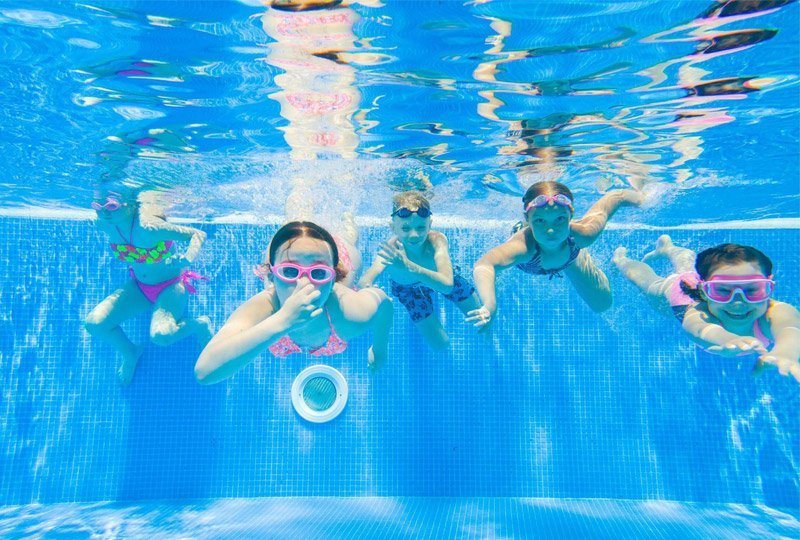The sun is shining and you’re so glad you decided to have a swimming pool built in your garden. Your family and friends love coming to visit to relax or enjoy parties and family time around your pool. What could be better?

But without careful and regular pool maintenance, your dream pool can quickly turn into a nightmare. Who wants to swim or party near a pool full of algae riddled green water, or one that’s providing a home for debris from the surrounding garden? Worse, still, a pool that continually needs filling up due to that elusive leak you haven’t been able to find.
With the above in mind, we have come up with our top ten pool maintenance tips to keep your swimming pool crystal clear and ready to use any time of the day or year. Contact us for swimming pool maintenance in Sussex, our professional team will ensure your pool is safe and healthy to use, give us a call to discuss your requirements on 01444 236578.
1. Use a pool cover
One of the best ways to speed up cleaning of your pool is to stop garden waste, dust and dirt from getting in there in the first place. A professionally fitted high quality pool safety cover provides great protection from the elements and all types of waste blowing around in the breeze. The key is to keep your pool covered whenever it’s not in use; especially overnight.
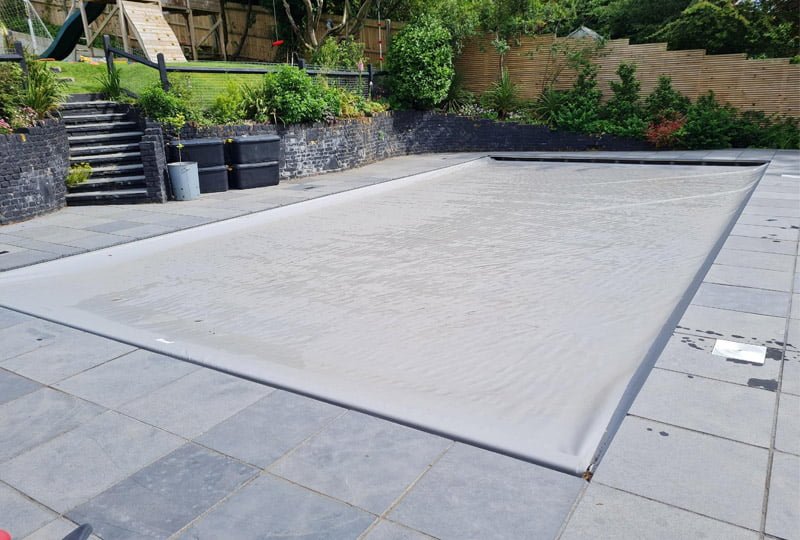
Pool covers can also provide protection from the rays of the sun which over time can fade your pool liner, tiles and pool surround. It also helps keep out the rain which over time can dilute the concentration of pool additives designed to keep your pool clean and clear.
Using a pool safety cover whenever the pool is not in use, will stop evaporation, conserve heat and the pool chemicals.
2. Mild chlorine wash around the pool deck area
A dirty pool surround can make even the cleanest swimming pools look uninviting. Regular cleaning of this area not only helps to make the whole pool look pristine but can prevent damage to the physical structure of the pool, liner and the copings or tiling.
We often hear of people recommending the use of a high pressure washer to clean around the pool area and copings, as a quick way to keep the pool looking neat and clean. We strongly advise you never to use a pressure washer in or around your pool. The high pressure water can damage pool liners, tiles, copings and may ‘blow out’ the joints. A much safer option is to use a mild chlorine solution.
SAFETY FIRST: Always wear goggles, a mask and gloves when using cleaning chemicals.
- Use a standard plastic watering can to mix a cleaning solution of one part chlorine with three parts water.
- Remove any pot-plants from the swimming pool area as chlorine can damage them if the cleaning solution gets into the plant’s root system. This concentration of cleaning solution will not cause damage to the grass.
- Remember to sweep away any loose debris before you start to use your cleaning solution. Otherwise you’ll risk washing them into your pool, leaving you with even more cleaning to do.
- Use the plastic watering can to carefully sprinkle the cleaning solution around the pool area.
- Then agitate the treated areas with a stiff outdoor brush. Always brush the cleaning solution and any debris away from your pool.
- Finally, rinse with clean water.
There are a number of cleaning solutions on the market that can be used to clear paths. Always read the product label to ensure it is safe to use on or around swimming pools before use. If you’re unsure, then contact us for more information.
3. Get rid of those pesky fallen leaves
A simple, low-cost way of keeping your pool sparkling clean and in pristine condition is to use a pool leaf net to skim off any leaves or other garden debris every day. This can be a great task to get your teenagers to help with. Once the job is done, there is the promise of a clean pool just waiting to be used.
Skimming the pool is fine, but it can be tricky to remove debris from the bottom of your pool. More and more of our customers are using specialised pool equipment such as an automated robotic pool cleaner.
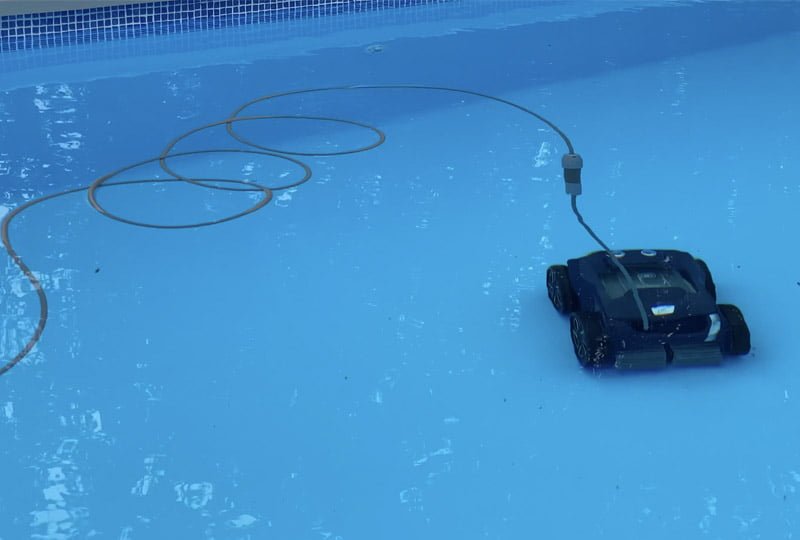
These can appear to be expensive until you consider the cost of someone cleaning the pools manually every day. Typically you or your pool maintenance person will spend 2-3 hours per week removing debris and cleaning the pool floor, plus another hour or two per week cleaning the waterline. Using a robotic cleaner can save you both time and money over the course of a pool season.
A robotic cleaner can not only clean the pool floor, but many can climb the pool walls to clean away any algae growth accumulating around the waterline. The more advanced models can be programmed with a pool cleaning schedule to run at times when the pool is not in use; perhaps getting the pool ready for your early morning dip?
At Hydrocare, we always have an automated pool cleaner available for you to borrow. If after a few days you decide this is something you need, we can provide one for you from one of our preferred partners.
Remember, the more leaves and organic debris in your pool, the less effective your chlorine becomes. Keeping the pool free of organic debris will help the chlorine last longer.
4. Test the water
Testing the water is easy and there are several ways this can be done:
- We can provide kits for home use, or you can buy them online
- We can do a full analysis for you using our state of the art digital water testing equipment. We will then provide you with a detailed analysis of the state of your pool water, measuring against up to 25 parameters including PH levels and chemical balance. Our digital water tester can even email you the results instantly.
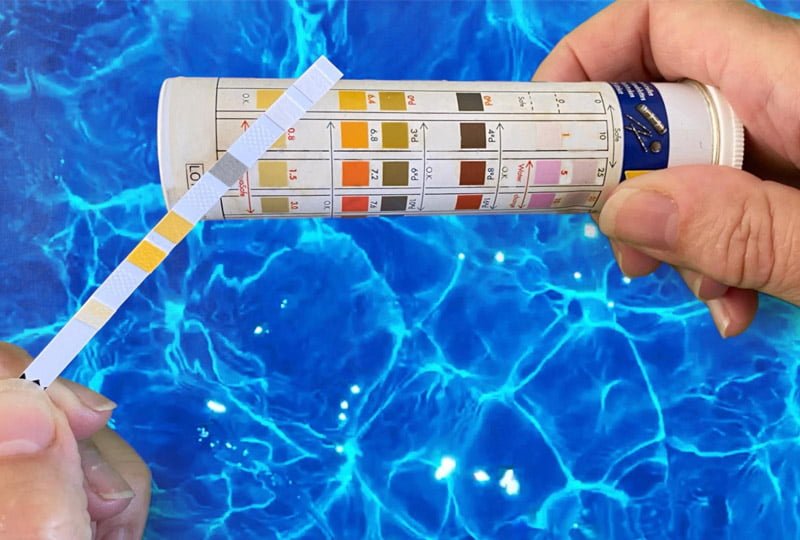
How to test your pool water at home
- If you’re using an inexpensive test kit made up of vials and coloured sticks, then just fill a vial with a sample of your pool water and place one of the coloured sticks into the vial of water.
- The coloured sticks will gradually change colour. Wait for the recommended time and then compare the colours on the stick to the manufacturer’s chart, usually found on the back of the test kit. This will reveal the chemical balance in your pool.
There are also digital water meters on the market that can be used to test the health of your pool water. They usually provide a digital readout on an LCD screen and can the highly accurate. However, some require calibration before use. For best results, just follow the manufacturer’s instructions. Some digital test meters do not require the use of any test sticks.
If the test reveals the water needs to be treated, then do so immediately. When the chemicals in the pool are properly balanced then the water will be crystal clear, with no oily film on the surface and no odour other than a faint smell of chlorine.
We recommend testing the pool water every week in the summer months.
5. Dosing the pool
Properly balanced chemical levels are crucial to a healthy pool. Too much chemical additive can irritate the skin and eyes and even cause breathing difficulties for some people. Not enough additives and over time bacteria can breed which can be harmful to health. Also, your pool will start to become cloudy and algae may be able to thrive.
So which levels should you use or check in your pool? The most common pool chemicals are:
Chlorine
A disinfectant that kills bacteria and algae and it is commonly used to treat swimming pool water. The ability of chlorine to oxidise matter and kill micro-organisms is directly affected by the pH level in the water.
Cyanuric Acid (pool conditioner or stabiliser)
A pool additive designed to make chlorine last longer. Chlorine can degrade when exposed to sunlight. The addition of Cyanuric Acid to your pool helps to reduce the impact of the sun on chlorine degradation. The recommended ideal range is 40-60 ppm (parts per million).
pH
A measure of the acidity of water and directly affects some of the chemical reactions that occur in the swimming pool water. It is measured on a scale of 0-14; with 7 being neutral, 0 being very acidic and 14 being very alkaline.
A high pH level adversely affects the ability of chlorine to kill micro-organisms. At levels in excess of 8, scaling may appear and the water may become cloudy. If pH falls below 7.0 the acidic condition will cause irritation to the eyes and mucous membranes of swimmers. Acidic water can also corrode metal parts of a pool system and damage the pool finish and surrounds.
Total Alkalinity
A measure of all of the acids and alkaline in the water. If this is out of balance and either too low or too high, the recommended doses may not be reliable or effective. Keep total alkalinity at the manufacturer’s recommended levels to avoid unnecessary spending on chemicals to try and correct the imbalance. Total alkalinity stabilises pH levels. The ideal pool pH level is 7.2 to 7.6. The ideal total alkalinity level for a pool is 80 to 120 ppm.
Calcium hardness
This must be actively managed along with pH and total alkalinity, to keep pool water in proper chemical balance and to prevent damage to your pool surround or liner. The current UK standard suggests maintaining calcium hardness in the ideal range of 200–500 ppm in pools.
The Langelier Index is an approximate measure of the saturation degree of calcium carbonate (CaCO3) in water. It is calculated using the Hydrogen Ion (pH), Alkalinity (CaCO3), Calcium concentration, total dissolved solids (TDS), and water temperature of a pool water sample. It will identify how ‘passive’ or ‘aggressive’ the water is. The key is to aim for a balance between the two; aggressive water will dissolve grout, metals, etc. High calcium levels and TDS can result in limescale and ‘plating out’ of scale onto surfaces.
Water Temperatures
Temperatures above 28c/82.4f can cause damage to pool liners. In these circumstances, any manufacturer’s warranty is likely to be void. High pool temperatures cause chlorine to dissipate faster, algae growth, and the formation of scale (calcium carbonate deposits) is more likely to occur.
Swimming Pool Salt
A growing trend as an eco-friendly alternative to Chlorine. Saline electrolysis does away with the need for large quantities of chemical chlorine additives for your pool and is effective in counteracting bacteria and algae. Electrolysis can be used to convert salt (NaCl) into chlorine and lye. The equipment converts the Cl element into a gas that is absorbed by the water, creating chlorinated water for your pool.
The benefit of this method is you no longer need to also add chlorine, which means a cost saving and no more chlorine odours in and around your pool. Additionally, the chlorine created drives down the pH value, which means relying on acid to control pH levels becomes virtually superfluous.
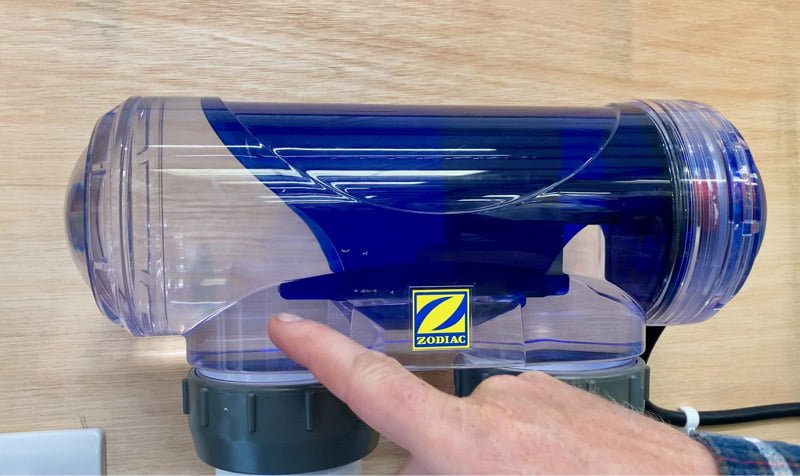
6. Backwash your pool filter
Your pool filter works constantly to remove impurities and small debris such as dead algae and microscopic particles too small to be caught by the baskets. You can help keep your pool system clean by turning off your pool’s filter and pump system and removing the basket(s) around your pool or in your pool pump room and clearing out any debris. This should be done regularly and at least weekly.
Each month you should clean out the pipes and main filtration unit in your pump room. This is done by a process known as ‘backwashing’. This process flushes out the very small particles of debris caught in the silica sand or glass filter media. If your pool is not staying as clean as it once did, it may be time to change your filter media.
There are speciality chemicals (flocculants) you can add to your system that can ‘lock together’ smaller particles to help your filter media capture the very minute particles, that would otherwise pass through it. We recommend changing your filter media every 5-7 years to maintain the optimum efficiency of your filtration system.
All modern systems have a ‘backwashing’ setting. Once the power is turned off, set the system to backwash which effectively reverses the flow of water through the filters and pipes (but not back to your pool) to loosen debris and flush it away. Once the process is complete, a short rinse is required. You can then return the system to normal filtering.
If you want to see how to backwash a pool, take a look at our Youtube video on it.
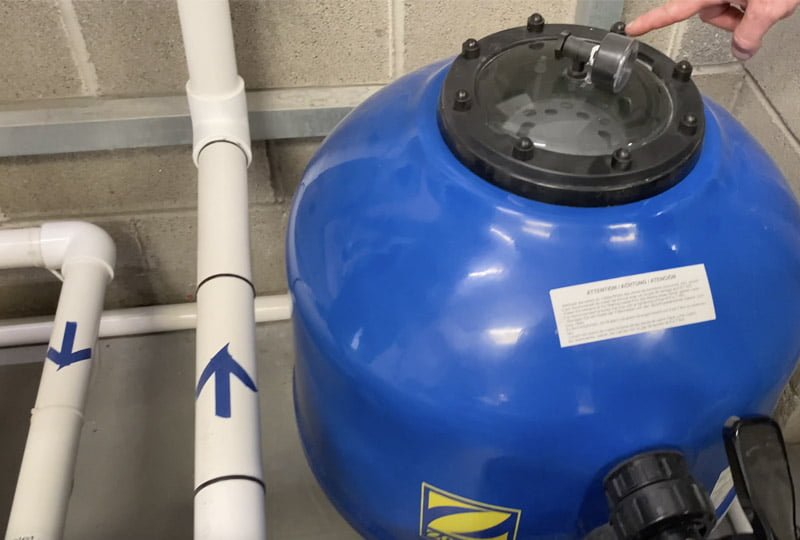
7. Don’t be afraid to ‘shock’ a cloudy pool
So what makes your pool go cloudy? One reason is an increase in the levels of bacteria. Think about how your pool may look after a pool party, or a public swimming pool may look after extended use. You’ll want to get rid of the bacteria as soon as you can.
What is ‘shocking’ a cloudy pool? Essentially it involves rapidly raising the chlorine levels for a short period of time to kill off bacteria and algae, using liquid or ‘shock’ chlorine. The act of shocking a pool is to at least double the amount of chlorine in the pool for a short period of time. Nothing can survive in such high levels of chlorine.
Green water is usually a pH level of 8.2 or higher. Once chlorine, pH minus and algae eliminator have done their job, the chlorine levels reduce naturally.
Shocking the pool too often can cause damage to your pool, surrounds or equipment. At Hydrocare we recommend shocking your pool once per month per pool season. You can occasionally shock the pool more often if you urgently need to resolve a cloudy water problem.
8. Don’t ignore a falling water level in your pool – it may be caused by a leak
The pool water level will naturally fluctuate after a pool party with kids (and adults) ‘bombing’ the water, after heavy rain or a period of prolonged sunshine. Typically, an uncovered pool can lose 3/4 inch (19mm) per day in the summer months.
The water level in your pool is a key indicator of its underlying health. The correct water level is around halfway up the opening of your skimmer. It’s fine to top up low water levels using a garden hose or pool water input valve (if you have one fitted). If the water level is too high, then use a pump to remove the excess water, or do a long ‘backwash’. You can rent a pump or you can contact your pool maintenance company who will remove excess water for you.
If your pool water level drops after topping up and it hasn’t been used or is affected by adverse weather, then your system may have a leak. Check all pipes and connectors. If nothing is leaking then the problem may be with underground pipework or even the integrity of the pool itself. This really is a job for the professionals. Dealing with a leak promptly when it is small can save you a lot of time and money in the longer term. Hydrocare Leisure offers a leak detection service – contact us for more information.
9. Regularly service the pool and equipment
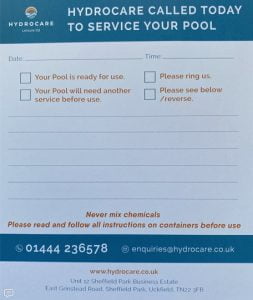
Modern pools are run by a whole range of specialists and often complex equipment. Unless you have the necessary expertise, you should leave servicing and replacement of items such as pumps, filtration systems and pool heaters to the experts, such as Hydrocare Leisure.
Plan to get your whole pool system inspected by an expert at least annually. This is often best done just ahead of the start of the pool season. That way, you’ll be able to use your pool and plan events with family and friends with confidence.
Let your pool engineer know of any faults or concerns you have about your pool before they commence the service of your pool. This can save a lot of time and money for everyone concerned.
10. Close the pool professionally at the end of the pool season
It’s the end of another great pool season and you may be thinking that all you now need to do is turn everything off and cover the pool until next season. However think of the stress when you take off the cover next year only to find that the pool has leaked, become contaminated or perhaps taken on water from an underground water source through a damaged pool base or wall. At this point, repairs can be costly and you’ll be competing for a pool engineer’s time along with everyone else who wants their pool re-opened for the start of the new pool season.
The ideal way to avoid these problems is to ask your friendly pool maintenance company to professionally close your pool ready for winter.
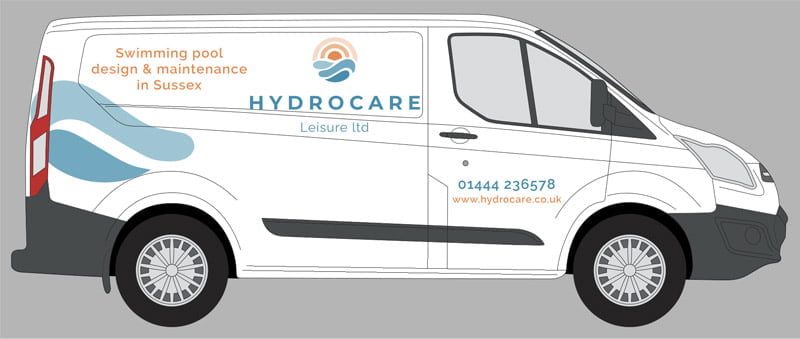
Winter months are an ideal time to get your pool serviced. At Hydrocare we offer low cost winter services. Call us on 01444 236578 for details.
When we decommission pools, we remove around 12 inches (30cm) of water, to allow the pool to refill naturally with rainwater or groundwater during the closed season.
NEVER empty the pool completely at the end of the season, unless there is a technical reason and you have been advised to do so by your pool maintenance company, ahead of essential repairs.
Finally, there are a few things you can do yourself before closing your pool:
- Test the water using a coloured dipstick and vial, or a digital water tester. Adjust the chemicals in your pool as necessary and re-test a few days later.
- Remove and clean all baskets/filters.
- Backwash your pool filters if you have the expertise and training to do so.
- If you do not have a frost-stat fitted, drain all equipment to prevent frost damage. Heat pumps, pipes and filters should also be drained.
- Chlorine wash the pool surround.
- Clean any algae around the pool edge.
- Make sure your winter debris pool cover is fitted properly to keep out falling leaves, branches and other debris.
Get in touch for professional pool maintenance in Sussex
We hope you found these tips useful, if you would like more information on pool maintenance or would like to speak to us about any of the products or services provided by Hydrocare Leisure Limited, then please contact us.
